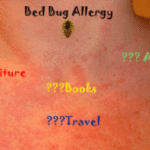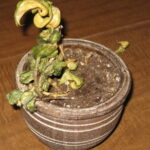Bed bugs have long been a thing of old time movies, cute phrases, and a history that seems so long ago. However, bed bugs have been increasing their numbers and the number of hotels, homes, and other lodgings that they reside in over the past few decades. Contrary to many beliefs they can come home to anyone and no matter how clean or how dirty your house is you could end up with a bed bug infestation.
What is a bed bug?
There are actually several species of bed bugs all over the world. They are also in all fifty states of the United States. They take such a name because their dietary needs and nocturnal lifestyles have been met very well by humans and their beds. Bed bugs are small pear shaped brownish colored bugs that get no bigger then 1/4″ or about the size of an apple seed. They lay eggs, and their nymphs hatch as tiny pin head sized bugs that are white to yellowish in color. The entire lifespan of a bed bug requires that at some point in time it has blood from a mammal to feed on. In order to reproduce it must consume a meal of fresh blood, and in each of the five nymph stages it must have a meal of blood.
Bed bugs live in and around beds where they can find lots of hiding places and they don’t have far to go for their nightly outings. This may seem terribly dangerous because they are a blood sucking creature and many other blood sucking creatures pass disease, however the bed bug is not a health risk. It still isn’t pleasant to have around and their bites can be terribly itchy and annoying.
Determining if you have bed bugs.
While it may seem easy to tell, it really isn’t. Few people catch bed bugs in the act and because they only come out at night they are hard to spot. Additionally some people don’t have a reaction to their bites while others can be bitten hundreds of times in as long as six months without having a reaction. Many people who do get bit often blame it on other insects and spiders as well. So, figuring out that you have bed bugs isn’t always easy to do before there are lots of them.
Identifying Bites.
Bed bug bites look a lot like mosquito bites. However, they tend to be in groups or rows. You will see three to five bites in a row or group, usually near the same blood vessel. Often these bites occur on the arms, legs, and back. They are often itchy, much like other bug bites.
Other ways to determine if you have bed bugs.
Check for signs of bed bugs. The easiest thing to notice is that bed bugs will often leave reddish, brown, or black spots or streaks on the bedding or mattress. This is because they are letting some blood out and leaving fecal matter as they go. While bed bugs are often hard to find, their debris isn’t. You can find eggs (tiny white eggs from hatched nymphs and amber colored ones that are still waiting to hatch) and exoskeletons that are left behind as bed bugs grow into adult hood. These look like amber, brown, or reddish colored shells or bits of dead bugs (thought the bugs that used those shells are still alive somewhere). These things can often be found in cracks, creases in the mattress, between the mattress and the box spring, and other dark and crowded locations in the mattress and box springs or in the near by area.
Finding bugs.
Sometimes you may not know for sure that it is bed bugs that you have. To figure it out you may want to find a bug to check. You can do this in two different ways. The first is to sleep with a flash light. If you wake up in the night then shine the light on your body and over your sheets looking for bugs.
If you don’t have a flashlight or this doesn’t work then it is a good idea to get double sided sticky tape (such as carpet tape) and attach it to the corners and edges of your mattress and box springs, the floor around the bed, and even the base boards. Make sure you put it in locations where you aren’t likely to get it stuck to you as you sleep or get in and out of bed. Leave this tape there for four to seven days and then check for bugs. If you have bed bugs you should have some after a week that have gotten stuck to the tape.
Treating bed bug bites.
Bed bugs bite a lot and for many people these bites are itchy. The first thing to do is to try and not itch and scratch it. This can lead to infection and isn’t good for the skin. You can put cortisone and other anti itch medicines on it to relieve the itch. Another option is to make a paste out of baking soda and try that. You can also bathe in baking soda water if you are feeling particularly itchy.
What to do once you know you have bed bugs.
Bed bugs are hard to get rid of because many times killing their eggs is hard. Additionally you only need one female to survive and chances are good that you will find yourself with more bed bugs. It takes two weeks for bed bugs to hatch, but a female can lay one to twelve eggs a day. Additionally, bed bugs can go for 12 months without food. Once food is available again they will begin eating and multiplying again. With this thought in mind an exterminator should be called in to help get rid of them.
Vacuum.
The first step to getting rid of bed bugs is to vacuum the mattress, box spring, and the bed frame. Anywhere that there is a small crack or space, there could easily be bed bugs hiding and you can suck them up with the vacuum cleaner. You will also want to vacuum under the bed and all around the space. Make sure that once you have vacuumed that you clean the vacuum out right away. This means taking the vacuum cleaner bag and tightly tying it into a garbage bag and throwing it out. If you don’t have a vacuum cleaner bag then empty the vacuum cleaner and take the debris to the garbage right away. This is important because you can let the bugs crawl out out of the vacuum if you wait to do this.
Wash it all.
If it is around the bed then you should throw it in the washer (if it can be washed). It should be washed in hot water and then dried in the dryer for an hour. This will kill bugs and nymphs in the material. This includes your bedding, your curtains, and if possible things like stuffed animals and pillows.
Bag it.
You can bag everything that doesn’t go in the washer in XL Ziploc bags or garbage bags that have been tied very tightly. You can then put them outside. If it is very cold (below 32 degrees Fahrenheit) or very warm (above 90 degrees Fahrenheit) you can get rid of them with a day outside. This works well in the hot sun. Bag it in black and it will bake even better killing more bugs, nymphs, and eggs. Bed bugs die at freezing and at about 113 degrees Fahrenheit so you will want to make sure it is sufficiently cold or hot. If it isn’t then it is a good idea to leave them out awhile and let them get very warm in the plastic bags. This works for pillows if you aren’t washing them, stuffed animals and other stuffed toys, and other items that just don’t do well in the washer.
Cover it.
It is a very good idea to cover your mattress and box springs. You can get a zippered cover that will completely go around your mattress and then your box springs. This makes it harder for the bed bugs and it will also trap those that are in the mattress or box springs. They will then die over time because they are being denied food. They will also stop reproducing.
It is important that you get something to kill the bugs. There are several do-it-yourself options out there and you can certainly try it, however many report having paid for the do-it-yourself options only to call an exterminator later on. With this in mind it might be a better option to call the exterminator first and skip out on the treatments. Many times it takes multiple visits from the exterminator. It is a good idea to follow all of his instructions so that you can limit how many trips he has to make.
Sadly, bed bugs don’t care if you are a clean person or a dirty person. They are something that will come home with you either way as long as you come in contact with them. They are bugs that hide out in clothing, luggage, and items such as bedding and pillows. It is a good idea to check for signs of bed bugs at the hotels that you stay in and to be aware of any friends or family members that might have them. While at first it might be embarrassing it is important that you let others who might have gotten them from you so that they can keep an eye out for signs. That way we can all battle them together.
“Good night, sleep tight, don’t let the bed bugs bite.”







